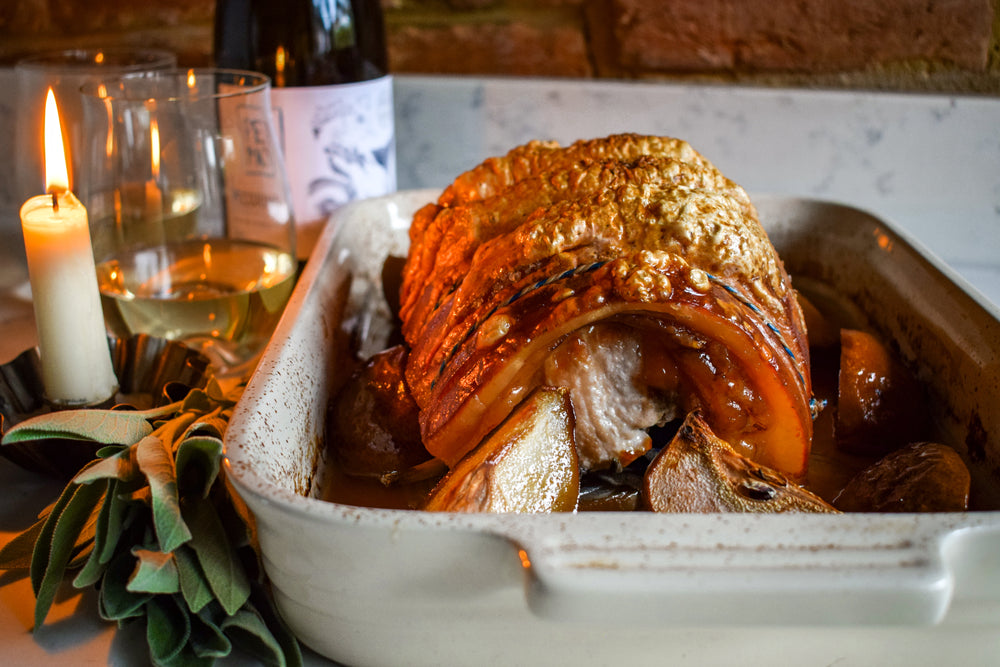
Roast Pork Loin with Pears & Sage
Instructions
1. 24 hours before you plan to start the roast, remove the pork from the butchers paper and place on a large plate. Spoon the salt over the skin and pat it into the pork, focusing on where the skin has been scored and making sure as much as it as possible has been covered. Leave to stand uncovered in the fridge.
2. Pre-heat the oven to 220C.
3. Thinly slice the onion and arrange the slices on the bottom of a large roasting dish with shallow sides. There should be plenty of room for the pears to be placed around the top without crowding the dish; this will cause the pork to steam not roast, and will prevent the pears from caramelising. Place the sage sprigs on top.
4. Over the kitchen sink, brush as much salt off of the pork as possible before patting it dry with kitchen paper. Place it on top of the prepared onion trivet. Pour the wine around the pork, taking care not to get any on the skin.
5. Roast the pork for 30 minutes, before reducing the heat and roasting for a further 2 hours. Check the pan occasionally; you want dark, reduced bits of pork, onion, wine and sage juice to make a good gravy, but if any look at risk of burning add a splash of water to stop things from drying out - all of this will depend on the size of your dish.
6. With an hour to go on the pork, quarter the pears and arrange them around the pork, cut side down and return them to the oven.
7. Remove the pork from the oven and if you’re planning on slicing it at the table, wrap the bottom half of the joint in kitchen foil, leaving the crackling open to the air. If you want light, airy and crunchy rather than thick and slightly chewy crackling, blast it under the grill for a few minutes before wrapping it, but keep an eye on it - because it has been salted it will bubble up in just moments! If you’re slicing the pork away from guests, remove the crackling with your carving knife before wrapping the pork. Leave somewhere warm to rest for 30 minutes. Transfer the pears to a bowl and do the same; if you don’t have space to keep them warm, make sure the bowl is oven-proof and return them to the oven for a further 5 minutes alongside whatever sides you’re finishing up to warm through again.
8. To make the gravy, pour a little boiling water from the kettle into the roasting dish to loosen the onions. Spoon the onions and sage sprigs up into a sieve so you can press out any excess cooking juices with the back of the spoon back into the dish. Use a fork or even better to prevent scratching the dish if it is ceramic a rubber coated whisk to scrape up as many of the delicious brown bits as possible into the liquid. If you have any properly burnt bits, avoid scraping those.
9. Pour the liquid from the roasting dish into a gravy separator jug to skim out the fat, then pour the gravy base into a small saucepan. Set it over a medium high heat and sparingly add water (from the carrot pan if you happen to be cooking some for extra flavour!) until you’ve created enough to serve everyone. Season to taste with salt and pepper, and thicken gradually with a little cornflour mixed into paste with water. This will create a thin, jus-like gravy: we’re not going to stop you if you also want to whisk in a little of your favourite gravy thickener here instead!
10. Serve the pork on a serving platter surrounded with the pear pieces if you’re not plating up in the kitchen.
Ingredients
Available online
-
2kg rolled pork loin
Available in store
- 2 tbsp flaky sea salt
- 1 large onion
- 3 large sprigs fresh sage
- 2 comice pears
- 60ml dry white wine
- freshly ground black pepper
- cornflour